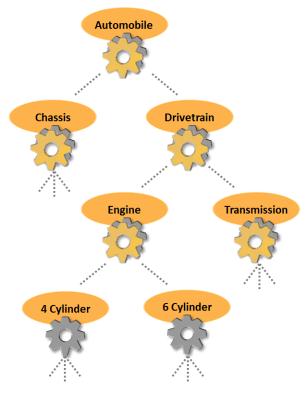Standard and Configurable Part Structures
Two kinds of part structures are available in Windchill: standard and configurable. Standard part structures are used for products that do not have optional components and cannot be customized. A standard product that is shipped to a customer usually contains the latest released versions of all parts without any customer-selected options.
Configurable part structures allow customers to choose from prescribed or custom-designed options. An assemble-to-order product contains a finite list of discrete modules that provide key product capabilities. Once the product design is complete, the product can be ordered and manufactured without the involvement of the product development team.
For example, an automobile can be ordered from a prescribed set of optional capabilities controlled by rules that determine what options can be selected together. The following example uses the optional part structure of an automobile to illustrate an assemble-to-order product:
The double-gear icons represent configurable modules within the automobile structure. In this example the customer chooses between a 4 and 6-cylinder engine. Other options are available depending on the engine choice. For example, you can choose a manual or automatic transmission with a 4-cylinder engine, but if you choose the 6-cylinder engine, only the automatic transmission is available. The 4 and 6-cylinder engines each have their own standard part structures, and once an option is selected, the latest released versions of all parts are used to build the automobile.
For more information about configurable part structures, see
Overview of Product Configuration Strategies.

